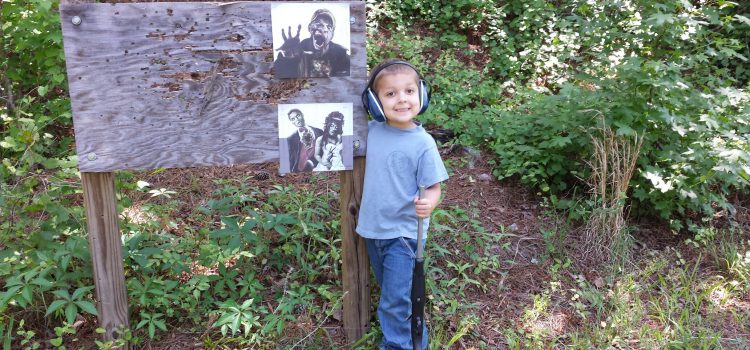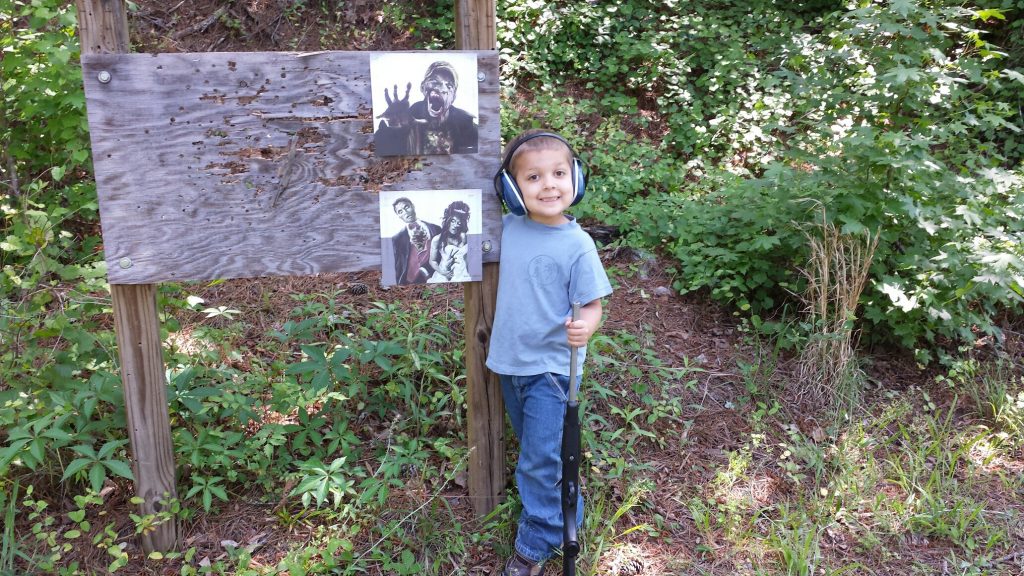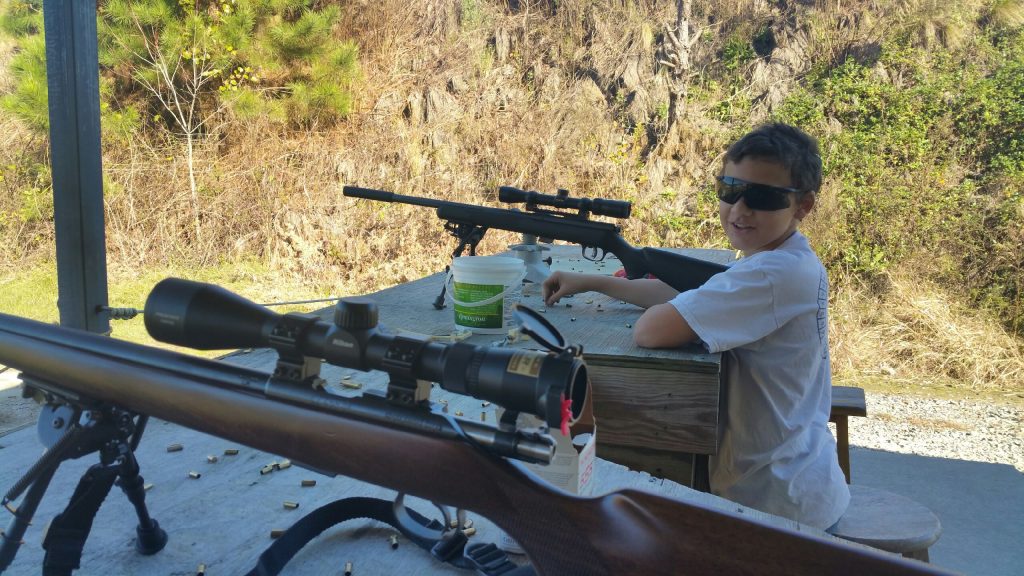We’ve all seen on the news here lately talking about guns and kids. With the headlines reading, “Kid Shoots Intruders” or even “Child Shot By Accident,” kids and guns are a touchy subject for some. Back in 2014, in Arizona, a 9-yr old girl accidentally shot the instructor while she was shooting a full-automatic UZI. Now, would I have given a 9-yr old girl a full-auto UZI to begin with? No! Are you freaking nuts!? Have you ever held an UZI before? They are really heavy and cumbersome to shoot. Now, shooting full-auto is amazing don’t get me wrong. I call it the giggle trigger and it’s freaking amazing to shoot in full-auto. But then again, I’m also 5’10” and about 250lbs, so shooting full-auto is more tolerable to me than a 9-yr old weighing an average 60lbs soaking wet. So let’s think about this at another angle. What is a good age to get kids involved in shooting and what kind of rifles, shotguns, and pistols should they shoot to begin with?
***Disclaimer: I am not here to start a political war, nor am I going to engage in any politics. This article was written for what kind of pistols, rifles, and shotguns should kids start off with when it comes to shooting and at what age it should happen.***
At my local gun-range, the rule states that “anyone under the age of 16 shoots free and must be accompanied by a parent.” No big deal right? I see kids that are ranging from the ages of 7-10 that are out there shooting with their parents. Typically I see dad, but I have seen mom out there as well, making it a family outing. I myself do not have any kids yet, but plan on having some in the future, and I often wonder at what age am I going to take them shooting?
When I was growing up, I was shooting BB guns around the age of 5. Growing up in a rural county in NC, hunting and fishing was the thing to do when you were a kid. It was part of life. My grandfather taught me gun safety as a child and I still to this day remember shooting soda cans with BB guns. I also remember him saying, “don’t shoot at anything unless I plan on eating it, except black birds.” He was a farmer and the blackbirds could potentially ruin the crops. So they were okay. But he also taught me not to point a gun at anyone unless you are being attacked. Also, he taught me to know my target and what was around it and beyond it. He taught this to not only me, but to my brother’s and cousin’s. This has always stuck with me, and I was only 5. So at what age do you start teaching about gun safety and gun awareness? Talking with parents, I asked them what their take is on guns. Most of the responses I got were, ”I teach my kids to tell an adult if a gun is present and to not touch it and they know it can harm them.” That makes great sense and I support that, as well as the stranger danger effect. But in today’s society, most households have at least one firearm for protection or for hunting.
Age
So again, I ask, what age do you start teaching about gun safety and gun awareness? In my opinion, it should be taught when the child can truly understand firearm safety and have the ability to stay focused on tasks for some time. I know kids have the attention spans of gnats and can have the “squirrel effect” very easily, and so can some adults, but they have to understand the importance and really grasp what is going on in front of them when it comes to firearms. Also, make sure you are with them at all times when they are around the firearms. A good rule of thumb, don’t let them touch any weapons or ammunition without you being present. We have all seen what happened to Ralphie when he got his Official Red Ryder Carbine Action, two hundred range shot model air rifle with a compass in the stock and this thing that tells time. He nearly shot his eye out! Everyone said he would do it, and he almost did, because he didn’t have the proper training, nor did he know what would happen if he shot a BB at a metal sign. So knowing proper safety will go a long way and also making sure you are wearing proper ear and eye protection at all times on the range.
Repetition is a great thing to practice as well. Having a routine will also help. I am no psychologist and I have never claimed to be, but I know as an adult, we generally perform better when there is a routine. Another good rule to remember is, don’t force your kids to shoot if they don’t want to. It is their decision if they want to be involved with shooting. I know my 10 year old cousin likes the idea of shooting and shoots his BB gun very well, but when we get to the range, he tends to freeze up and becomes very shy when we are shooting firearms other than a BB. He knows all about gun safety, but sometimes, he just doesn’t want to shoot. So knowing their limits is great. This will also help out if you are at a range with a lot of people, teaching them proper range etiquette is a must. Knowing what a “hot” line is and a “cold” line as well.
Remember, a family that shoots together, stays together. Having more than one person teach a kid can go a long way. Like I said, my grandfather taught me things about gun safety and gun usages, as well as my dad. But as children, when you act up, you either have to be disciplined by mom or dad. So I tended to listen to a third party better because they kind of understood what being a kid is about. So having family there to help support you will go a long way. Having friends, siblings, cousins, etc. help with teaching will give your child a different outlook on guns. Each person has their own way of shooting and have different experiences they could share.
<script async src="//pagead2.googlesyndication.com/pagead/js/adsbygoogle.js"></script> <!-- EpicTactical Responsive --> <ins class="adsbygoogle" style="display:block" data-ad-client="ca-pub-6322371667784146" data-ad-slot="4109136348" data-ad-format="auto"></ins> <script> (adsbygoogle = window.adsbygoogle || []).push({}); </script>
Rifles
BB guns make excellent starter style rifle and pistols that will get them acclimated to safety and awareness. It will also help them understand sight picture and aiming without breaking your wallet. When I got a little bit older, I gradually moved from BB guns to my first .22LR rifle and my first .410 shotgun. These long guns make perfect starter guns. I didn’t get my first .22LR until I was about 8 or 9. It stayed at my grandparent’s house because they had the land that we could shoot on. My rifle stayed locked in the closet and the key put up high, so I was not able to reach it without an adult. A .22LR makes a great first little rifle due to the low recoil and cheap ammunition. My father bought me a Savage .22LR bolt action. I absolutely love this little rifle. I plan on giving it to my kids someday and it can stay in the family and I can teach my kids how to shoot with it. But a bolt action makes a really good trainer rifle. It can only shoot one bullet at a time, and then you have to pull the bolt back and load another round into the chamber. This rifle has a 10rd magazine and is very affordable. Some other bolt actions include the Crickett single shot, CZ 455, Marlin XT-22, and the Ruger American 22. These rifles start around $100 and can be as high as $450. Most of these bolt actions are considered youth models, but some are for adults, so be careful when it comes to choosing one for your little person. I know that the Ruger 10/22 is a very popular first gun as well, and is a great survival gun. It is a semi-automatic action rifle and usually has 5-25rd magazines available. Also, lever action 22’s made by Henry or Marlin, make great little plinkers as well. It all depends on how comfortable you are with firearms as well, and have the know how to teach with these style rifles. Just a good .22LR in general, will make a great first rifle.
Shotguns
Shotguns are a little different. Do you get them a pump, semi-auto, or single-shot? My recommendation would be to get a single-shot shotgun. This will get them comfortable with that more powerful kick than the .22LR, without breaking the bank. Most used single-shot shotguns can be found for around $100 made by H&R. H&R also make youth model shotguns as well. Manufactures like Mossberg, Remington, Tri-Star, Stoeger, CZ, and Weatherby make outstanding shotguns for prices around $350 to around $550. You can never go wrong with a good pump and even a good semi-auto, but be mindful about which one you choose and again, be comfortable teaching on that platform.
Now, what gauge do you buy? I recommend a .410 shotgun as a good entry level shotgun gauge for kids. Ammo is not really expensive and is readily available at local retail stores. Another good gauge would be either a 28ga or 20ga for when the kiddos get a little bit older. I personally think a 28ga over-under shotgun with a short stock would make a great first shotgun for a child, because the recoil is hardly there. Tri-Star makes a great over-under 28ga for around $500. Whatever gauge you decide to go with, just be mindful of the load. You do not want to get the heaviest load for them to shoot straight out of the gate, because it could potentially turn them off to shooting a shotgun in general. So a light load to begin with would be the best option.
<script async src="//pagead2.googlesyndication.com/pagead/js/adsbygoogle.js"></script> <!-- EpicTactical Responsive --> <ins class="adsbygoogle" style="display:block" data-ad-client="ca-pub-6322371667784146" data-ad-slot="4109136348" data-ad-format="auto"></ins> <script> (adsbygoogle = window.adsbygoogle || []).push({}); </script>
Pistols
Now what about pistols? What would make a good first pistol for a child? I recommend the .22LR round. There are a lot of options out there for .22LR pistols that come in all shapes, sizes, and actions. There are .22LR pistols that are being produced by North American Arms, Taurus, Walther, Ruger, Beretta, and the list goes on and on and on. A good thing to remember when buying a .22LR pistol for the little ones to shoot is, make sure the gun is not too big for them. Kids have little hands, so what fits in your hands, will more than likely not fit theirs. Most manufactures make a good line of .22LR pistols that range from about $200-$400. You can also find used pistols at really good prices, so don’t be afraid to buy used. Most pistols come with the manufactures Lifetime Warranty, so no worries. I know Ruger makes the Mark III line of pistols that are great for target shooting, and they also make a smaller pistol called the SR22. Also, Smith and Wesson just updated their .22LR line of pistols with the M&P Compact 22 and the SW22 Victory Target Pistol. Both would make a great choice for the kids. Another forgotten .22LR pistol is the Single-Action Cowboy style pistol. These make great little shooters and are really fun for everyone. But with single-action cowboy style pistols, remember the hammer does have to be pulled back each time it is to be shot, and the kids might have a hard time pulling back the hammer, but it’s just another pistol you can choose from.
Summary
At the end of the day, safety is the most important thing when it comes to kids and firearms. In the 1950’s, firearm safety was being taught in school by local NRA chapters, as well as some local police departments. All new firearms come with a lock. Make sure to keep firearms locked, and secured away from children’s reach. YOU are responsible for that firearm, and it would be catastrophic if something was to happen to your child or someone’s child with your firearm. Think about not only the physical damages, but emotional and psychological damages that may occur. Teaching your kids about gun safety at an early age can help deter accidents in the future. I know in North Carolina, Hunter Education Classes are provided by the N.C. Wildlife Resources Commission. They provide free hunter education courses throughout the year in every county. The class not only teaches about firearm safety, but also talks about ethics and responsibility, conservation and wildlife management, wildlife identification, survival and first aid, specialty hunting and tree stand safety. Now, there is no minimum age requirement, but the classes are taught at a sixth grade level and tests must be completed without assistance. Hunting accidents have decreased by over 50% during the last twenty years with these Hunter Education Classes, making hunting one of the safest recreational activities in North Carolina. Ultimately, it is up to you, the parents, to choose if and when you want to engage your kids with firearms.
Ya’ll be good and be safe.





